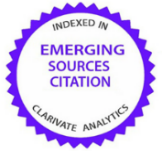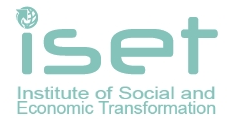Regulation of institutional changes in the social sector of the national economy: conceptual approach
Abstract
Introduction. The development of the national economy under the modern conditions is increasingly determined by the potential both of the commercial sector and also of the social sector development level since a number of economic policy tasks concern this sector. Issues of economic and social inequality are increasingly being explored in terms of their impact on economic growth in a long run. The complexity of implementing state regulation of the social sector to ensure inclusive growth raises a number of problems, because policies need to be coherent and institutional arrangements are effectively implemented.
Aim and tasks. The purpose of the study is to substantiate a conceptual approach to institutional transformations regulating of the social sector of the national economy, based on the principles of inclusive economic growth.
Results. According to the institutional changes theory, the formation of a coherent strategy regarding the state regulation of institutional changes in the social sector of the national economy requires consideration of the dependence on the previous way of development. So, the structure that is being formed requires both vertical (with basic institutions) and horizontal (with institutions formed within the social sector) coordination. Development of two mentioned types of interactions should be aligned with the strategy of state regulation of the social sector of the national economy - market-coherent and socially-coherent and gives the opportunity to achieve both social and economic (commercial) results, to balance the measures aimed at these interactions.
Conclusions. Within the framework of the problem of creation of an effective system of state regulation solution for ensuring inclusive growth within the proposed approach, the necessity of stakeholder interaction development, creation of an institutional and economic environment for the development of market-coherent and socially-coherent interactions considering achievement of economic growth with simultaneous achievement of social goals is ensured. Strategic direction of state regulation of institutional changes in the social sector of the national economy can be considered a gradual shift from the institutions of income redistribution to participation institutions (education, infrastructure, etc.). Education development is one of the priorities, as research findings indicate that the problem of access to education is a significant factor in inequality.
Keywords:
state regulation, national economy, social sector, inclusive growth, institutional changeReferences
2. OECD (2018). Framework for Policy Action on Inclusive Growth. Retrieved from https://www.oecd.org/mcm-2018/documents/C-MIN-2018-5-EN.pdf.
3. Ianchovichin, E., & Lundstrom, S. (2016). What is inclusive development? Report of World Bank Group.
4. Anand, R., Mishra, S. & Peiris, Sh. J. (2013). Inclusive growth: Measurement and determinants, IMF Working Paper. No. 13/135. Retrieved from https://siteresources.worldbank.org/EXTPREMNET/Resources/EP122.pdf.
5. World Bank (2018). Inclusive Growth: A Synthesis of Findings from Recent IEG Evaluations (English). Washington, D.C.: World Bank Group.
6. Karimova, A. (2018). Inkliuzivnyi development: kontseptsyia sdviga [Inclusive Development: The Concept of Shift]. Russia and the New Eurasian States, № 2, 130–153. DOI: 10.20542/2073-4786-2018-2-130-153 (in Russian).
7. Ramos, R., & Almeida, R. (2013). Inclusive Growth: Building up a Concept, Working Paper. International Policy. Centre for Inclusive Growth.
8. Pontara, N., & Times, V. (2018). Investing in people for inclusive growth. Retrieved from https://www.worldbank.org/en/news/opinion/2018/10/17/investing-in-people-for-inclusive-growth.
9. Rodríguez-Pose, A., & Tselios, V. (2015). Toward Inclusive Growth: Is There Regional Convergence in Social Welfare? International Regional Science Review, 38 (1), 30–60. https://doi.org/10.1177/0160017613505201.
10. WEF (2017). The official site of World Economic Forum, Inclusive Growth and Development. Retrieved from http://www3.weforum.org/docs/WEF_Forum_IncGrwth_2017.pdf.
11. UNDP (2013). Exploring and Strengthening the Intersections between Social Protection, Employment and Inclusive Growth. Retrieved from http://www.ipc-undp.org/publication/26527.
12. OECD (2014). Framework for Inclusive Growth. Retrieved from http://www.oecd.org/mcm/IG_MCM_ENG.pdf.
13. OECD (2015). All on Board Making Inclusive Growth Happen. Retrieved from https://www.oecd.org/inclusive-growth/All-on-Board-Making-Inclusive-Growth-Happen.pdf.
14. OECD (2016). Policy Shaping and Policy Making: Governance of Inclusive Growth Publishing, Paris. Retrieved from https://www.oecd.org/governance/ministerial/the-governance-of-inclusive-growth.pdf.
15. European Commission (2010). EUROPE 2020. A European strategy for smart, sustainable and inclusive growth. Retrieved from https://ec.europa.eu/eu2020/pdf/COMPLET%20EN %20BARROSO%20%20%20007%20-%20Europe%202020%20-%20EN%20version.pdf.
16. ABD (2018). Strategy 2030: Achieving a Prosperous, Inclusive, Resilient, and Sustainable Asia and the Pacific. Retrieved from https://www.adb.org/documents/strategy-2030-prosperous-inclusive-resilient-sustainable-asia-pacific.
17. Inclusive Growth Commission (2017). Inclusive growth for people and places: challenges and opportunities, RSA, London. Retrieved from https://www.thersa.org/globalassets/pdfs/reports /rsa_inclusivegrowth-commission-final-report-march-2017.pdf.
18. Vasilyeva, T., Lyeonov, S., Adamičková, I., & Bagmet, K. (2018). Institutional Quality of Social Sector: the Essence and Measurements. Economics and Sociology, 11 (2), 248–262.

This work is licensed under a Creative Commons Attribution-NonCommercial 4.0 International License.
If the article is accepted for publication in the journal «Economics. Ecology. Socium» the author must sign an agreementon transfer of copyright. The agreement is sent to the postal (original) or e-mail address (scanned copy) of the journal editions.





















